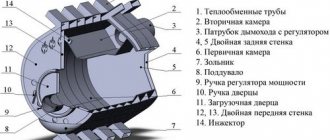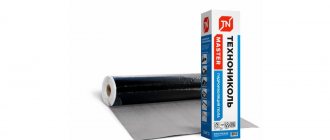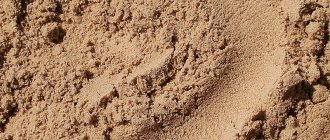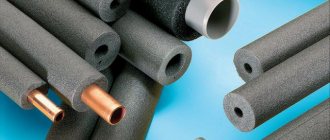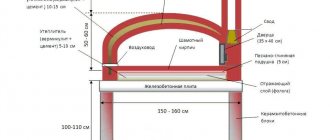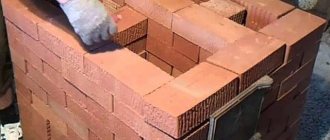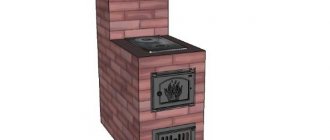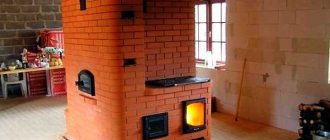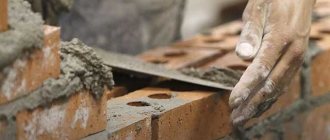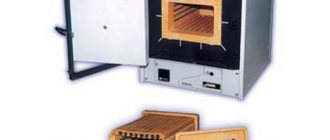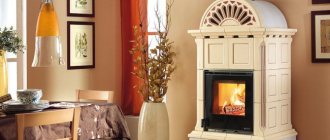Types of mixtures for laying fireplaces and stoves
Heat-resistant mortar is used for laying red brick.
Fireplace and stove structures are built from natural stone or refractory brick. To make the structure monolithic, various compositions are used. They are suitable for external masonry, firebox and chimney construction, pouring foundations, cladding and creating heat-resistant elements.
Based on the type of resistance to high temperature and fire, you can select a masonry stove mixture:
- heat-resistant – maintains the integrity and load-bearing strength of the structure at high temperatures;
- heat-resistant - protects the structural integrity of the masonry when exposed to fire and mechanical force;
- fireproof - the property of viscous products that are resistant to fire and the effects of combustion products.
The composition and proportions depend on the type of stove element.
Heat-resistant mixtures
Examples of heat-resistant dry mixtures for masonry stoves
The material is able to withstand heat, maintain the load-bearing capacity of the structure and not deform from high-temperature exposure. The standard mixture for pouring a monolithic firebox or erecting a frame is made on the basis of:
- 1 part of Portland cement grade M400-M600;
- 2 parts of ceramic crushed stone M150;
- 2 parts of fine quartz sand with fractions of 1 mm;
- 3/10 parts fireclay sand;
- water in the amount of 4 liters per 10 kg of mixture.
Purchased and self-prepared solutions are mixed in a concrete mixer - all ingredients are added gradually.
Finished materials are cleaned of organic matter, which eliminates the release of carbon monoxide during furnace operation.
Fireclay compositions
Crushed fireclay clay in a dry mixture for laying out the firebox.
A mixture based on refractory clay and quartz sand crushed to fine grain is characterized by:
- fire resistance depending on the manufacturer - from 1550 to 1850 degrees;
- average size of fractions from 2 mm
- moisture absorption - 2-10% for high-burnt fireclay, approximately 25% for low-burnt fireclay.
The fireclay product is supplied in 20 kg bags, which is enough for laying 20-30 bricks. The construction of the chimney and firebox is carried out from a clay-fireclay mixture in proportions 1:1. You will need ¼ of water.
On a note! Refractory clay is used for facing work, but only 4 weeks after the first fireplace fire.
Dry Potting Powder
Cement aluminate for preparing pouring mortar
Fire-resistant material based on cement aluminate and fireclay clay with fractions of 0.5 mm is used for pouring and repairing the internal parts of stoves, grills and fireplaces. Available in the form of a gray powder, scattered in 25 kg bags. Has the following properties:
- permissible minimum filling temperature - +5 degrees;
- hardening time - 1 hour;
- the yield of the finished mass is from 11 to 12 liters from a 25 kg bag;
- temperature resistance up to +1300 degrees.
The solution is mixed in a concrete mixer. You need to gradually add from 2.5 to 3.5 liters of water per bag. Large parts of the stove are poured with a layer of 50 mm, the roof - with a layer of 100 mm.
The refractory mass cannot be reinforced - its thermal expansion is less than that of metal.
Furnace mortar, clay mortar for furnace masonry
Kiln mortar consists of red clay mixed with sand, similar to red brick, but also used for fireclay brick masonry. Also, ready-made dry mixtures based on red and fireclay (refractory) clays are used for furnace mortar; the construction market offers these oven mortars in an assortment, with detailed recommendations for preparing the mortar.
But many stove makers prefer to prepare mixtures for stove mortar with their own hands, from pure red clay, without plasticizers or additives. This clay can be purchased packaged. Specialized quarries for the extraction of clay supplied to the production of bricks and ceramic blocks also supply red additive-free clay, the solution of which is ideal for laying stoves.
Clay for oven mortar
The basis of masonry stove mortar, which cannot be replaced by any other material, is red clay. Its properties are unique, and are on the verge of magic - the process of turning clay into stone under the influence of fire is a common miracle. Firing gives soft clay the strength of a brick, ensures excellent adhesion of brick and mortar into a single whole in the kiln structure and the highest fire resistance. Of course, provided that the clay masonry mortar is prepared correctly and the ratio of its components is optimal.
Not any clay is suitable for laying stove bricks, but only of a certain fat content. Experienced stove makers know how to select the proportion, taking into account the fat content of the clay used and adjusting the properties of the solution with the amount of added sand. The composition, as a rule, is selected experimentally, since there are no strict restrictions on the ratio of sand and clay in the solution.
Fat content of clay for mortar
Fatty clays contain sand impurities up to 3%. It is difficult to wash away with water, and a solution made from oily clay is not afraid of the condensation that forms on the surfaces of the stove. But a decrease in fatty clay volume (about 10-12%) negatively affects the strength of the seams; cracks may appear when heated. Adding sand to the solution reduces grease and prevents the formation of cracks.
Lean clays include a significant amount of sand - up to one third. Under thermal loads, they hardly crack; when they dry, they decrease in volume by only 5-7%. But their strength in masonry is insufficient. Medium clays are considered the best, and the most suitable option for masonry mortar. sand in medium clays up to 15%, volume reduction during drying is about 9%.
The optimal composition gives the masonry strength when heated to high temperatures for a long time.
The fat content properties of clay rocks are determined by the “harness” method. Rolling a lump of wet clay into an even rope about 10 mm thick and 20 cm long, wind this rope onto a wooden rod 5 cm in diameter. Fat clays of good quality show a smooth stretching pattern of the rope, cracks and breaks do not appear.
Characteristics of oven mixtures
High-quality mixtures for stoves and fireplaces must have the following characteristics:
- heating limit from 1300 to 1780 degrees - heat-resistant material does not crack when exposed to high temperatures;
- finished density from 1000 to 1800 kg/m3 – allows you to form a durable layer with high thermal conductivity;
- frost resistance - up to 70 freezing and thawing cycles allows for external and internal construction;
- heat resistance, strength and ductility - properties increase the service life of the furnace;
- environmentally friendly - materials without volatile impurities and chemicals do not emit carbon monoxide during the fireplace combustion process;
- flammability class - a heat-resistant product is classified as NG (non-flammable);
- vapor permeability – from 0.09 mg/m*h*Pa – prevents molding of the seam.
A good composition during operation easily adheres to the surface, has a plastic structure and is easy to apply.
Advantages and disadvantages
You can quickly prepare a high-quality solution from a purchased mixture.
For laying stoves and fireplaces, a high-temperature mixture is used, which contains clay, sand, lime or cement, and heat-resistant ingredients. To obtain a homogeneous mass, water must be added to the material. Using finished products has several advantages:
- ease of mixing components;
- ready-made recipe that ensures the strength of the composition;
- versatility of use - suitable for cladding, laying external and internal parts;
- attractiveness and evenness of the masonry seam;
- availability of complete instructions with operating and mixing rules;
- ease of application and no risk of seam destruction.
The use of building materials is associated with some difficulties. The mass is mixed only with a mixer or in a concrete mixer, it hardens quickly, so it is prepared in portions.
Composition and proportions of their components
When constructing stoves, a clay composition is most often used. In terms of its chemical content, it most closely matches the ceramic brick from which stoves are usually constructed. But for the construction of a foundation and a chimney above the roof, especially in rooms with high humidity, such as a bathhouse, cement and lime mortars are used.
Clay mortar for laying stoves, proportions and other characteristics can be found in this article.
They withstand the accumulation of condensation and do not crack under its influence.
The main components of stoves and fireplaces include: clay (cement or lime, respectively), water and sand. They must be of high quality and meet certain requirements:
Clay
Its red form is most often used. It acts as the main binding material. Its properties affect the density of the masonry. Based on the volume of sand it contains, it is divided into three types:
- oily (up to 3%);
- average (up to 15%);
- skinny (up to 30%).
Mortar for plastering the stove, composition and other data can be seen in the article.
Before use, it is imperative to check the clay for fat content using available methods. Another important property is plasticity, which depends on the number of inclusions, the size of its particles, water absorption and other factors. When it dries, it decreases in volume. On average by 6%.
Refractory, ordinary and refractory clay are used in mortars for laying furnaces. The latter, in its properties, corresponds to fireclay bricks (one of the types of fireproof bricks). Its usual form is used for ordinary red clay bricks. And the refractory variety is used together with sand to construct furnaces from refractory bricks.
Ready-made masonry cement mortar grade 100, price and other characteristics can be found in this article.
Sand
It is taken without various inclusions in the form of silt, vegetation residues, etc. Both quarry and river sand are suitable. The main thing when choosing it is that its grains should be in the range from 1 to 1.5 mm. For laying stoves made of refractory materials, fireclay powder or sand is used. It is preferable to use sand that is mined in a quarry; it adheres better to clay.
Water
It should not contain silt, salts and other impurities and be sufficiently clean. To prepare a refractory composition, it is necessary that its temperature be in the region of 12-30 degrees. Regular drinking water or collected rainwater is best.
You can learn how the plaster mortar is prepared from the article.
In addition to these components, additives are used in clay to improve its properties: salt and cement. If the first component is selected, then 100 grams of salt must be added per 10 liters of solution, and if the second component is used, 1 kg of Portland cement must be added.
The video shows a solution for laying stoves with your own hands:
The proportions of the solution for pouring the foundation can be found in this article.
Proportions
There are two types of compositions: simple and complex. In the first type, only one binding material is used - cement, clay or lime. And in the second, they can be combined and the resulting properties of the material can be adjusted. For example, sometimes cement-lime mortar is used for furnace foundations, which is most suitable for these purposes.
You can read about what proportions are needed for floor screeding in this article.
The correct composition is similar in appearance and fluidity to thick sour cream. It is better to choose clay of the same type as the brick for better fastening.
To prepare a solution from its fatty form, the composition is prepared from a 1:2 ratio. That is, one part clay to twice the volume of sand. And for the normal look the proportions are the same.
After preparing the solution, it is necessary to check its quality. To do this, they fasten two bricks together and wait a period of five minutes. After this, you need to lift the clutch by the upper brick, this movement must be repeated several times. If suddenly the bottom brick falls off, it means that it is necessary to adjust the composition by adding clay or water. To prepare a lime mixture, you need to take one part of its binder and combine it with three portions of sand.
How to lay bricks on lime mortar can be found in this article.
The video explains how to make mortar for laying a brick oven:
Selection of mixtures for structural elements of the furnace
Fireproof fireclay mortar is necessary for laying the firebox and elements close to an open fire.
To select masonry materials, it is necessary to take into account that the stove consists of several elements:
- The foundation cushion is a monolithic element built separately from the foundation of the house.
- The base of the furnace is not subject to temperature stress, therefore it is built from solid red brick. Lime or lime-cement mortar is suitable for masonry.
- Fire blind area - represented by a sheet of asbestos or mineral cardboard, on which there is an iron sheet and felt impregnated with clay.
- The furnace mass - due to the increased impact of hot flue gas on the structure, is built from ceramic bricks with clay mortar.
- The firebox gets very hot, so it looks like a monolith on a fire-resistant clay-chamotte mortar.
- The beginning of the chimney is heated to +400 degrees, which requires laying on a mixture with a clay base.
- Otter, or fluff, is an element connecting the chimney and the ceiling. Temperature and aggressive effects on it are minimal, so a lime composition is suitable for standard bricks.
- Fireproof cutting is a heat-insulating metal box that does not require a solution.
- The chimney and fluff are exposed to wind and chemicals. Installed using red solution.
The correct choice of solution will save 10-12% of funds on the purchase of consumables.
Lime mixture
Lime mixture is used for laying outdoor stoves, as it does not absorb water.
The fireproof mixture for stoves consists of sand, lime paste (1 part quicklime + 3 parts water). To prepare it yourself, you will need to sift the sand, mix it with the dough in a ratio of 1:3 and add water until the sour cream becomes thick.
The heat resistance of the product is from 450 to 500 degrees, but it is non-hygroscopic. The product is used outdoors to treat the part of the pipe protruding above the roofing. Due to toxicity and duration of contraction, lime materials are best used outdoors.
To increase strength, cement can be added to the lime mortar, and gypsum can be added to speed up adhesion.
Cement mixture
Cement-based mortar is used in foundation construction.
It is divided into three types:
- Cement - preparation requires water, cement and sand. Greater strength and low gas density allow the compositions to be used for foundation construction.
- Cement-clay - durable mortars, with the help of which the thermal part of the fireplace and the beginning of the chimney are laid out.
- Cement-lime mixtures are strong, but have a low gas density. Suitable for the construction of fireplaces, foundations, chimneys.
To make it yourself, you will need to mix 1 portion of cement with 1-3 portions of additives and 6-15 portions of sand.
The heat resistance of the cement mass can be enhanced using Portland cement and broken bricks.
Clay mixture
The material is suitable for the construction of a furnace array. The ideal mixture does not crumble, has a homogeneous structure without lumps and the consistency of sour cream. Factory materials are made on the basis of:
- white clay - increases the fire resistance of the mass, suitable for the construction of wood-burning stoves with heating of the firebox up to 1000 degrees;
- fireclay clay is a universal product that ensures the strength of the stove structure at any temperature.
To increase strength, you can add to the solution:
- table salt or sodium chloride - 100-150 g are needed for 1 bucket;
- Portland cement - for 1 bucket you will need from 500 g to 1 kg of product.
The consumption of clay mixture per 100 bricks is 25 liters.
Selecting the proportion and checking the solution
The solution must be tested for fat content using beads.
The amount of ingredients depends on the location and purpose of the stove structure. To build a structure in a house you will need:
- 1 part sand + 1.5 parts clay;
- 3 parts sand + 1 part lime paste;
- 1 part cement + 8-10 parts sand + 2 parts lime paste;
- a heat-resistant mass for a monolithic firebox is prepared on the basis of 1 part of portlad cement M400, 2 parts of broken brick, 0.3 parts of fireclay sand;
- refractory concrete can be made by mixing 20 kg of the finished composition with 8 liters of water.
A brick sauna stove is built on the following mortars:
- cement - 1 part cement + 3 parts sand;
- limestone - sand and lime have a 2:1 ratio;
- lime-cement - you need 2 parts lime, 1 part sand, from 6 to 16 parts cement.
The firebox is laid out using clay-fireclay mass. For plastering, asbestos + lime + sand + gypsum, clay + asbestos + sand or clay + cement + sand + asbestos are used.
For outdoor structures, it is better to use a moisture-resistant composition based on 3 parts sand and 1 part cement.
Mixture testing
The fat content of the solution is determined by the number of cracks when the ball is compressed.
The quality of the lime paste is checked using a wooden lath. During the mixing process, the type of mass is determined:
- there is no material on the plank - thin mortar, corrected by adding lime;
- lumps or film remain on the rail - the product is suitable for the job;
- a thick, dense layer remains on the board - a greasy mass, to which you should add a little sand.
Before using the clay solution, the fat content is tested. You will need to dilute 2 kg of clay with water, mix with a wooden stick and inspect it:
- Clay has stuck to the rail - a greasy substance that is hardened by sand;
- small pieces stuck to the blade - you can start laying;
- There is a film left on the bar - the material is thin, it needs to be corrected with rich clay.
Salt or plasticizers can be added to formulations to improve adhesion.
Clay mixtures by type and consistency
To prepare it, you need to take clay, red or white, combine it with sand and then add water. It is very important to use only high quality components for the mixture: for example, only calibrated sand is suitable. To clean it from fine gravel and various plant impurities, use a sieve. The same is done with clay, achieving its homogeneity. As a rule, the following proportions are used: 1 part sand and clay, or 2 parts sand and 1 clay. The water in the solution should be approximately ¼ of the amount of clay.
The main criterion for the finished mortar is
its level of fat content , which determines the elasticity and astringent properties of the mixture, and therefore the reliability of the future structure.
It is also worth paying attention to the purity of the water used: it is better if there are fewer minerals in it. Otherwise, stains may appear through the plaster in the future, which will be caused by sufficient mineralization of the liquid. The finished mortar for the stove should be moderately greasy: too soft will lead to the fact that the finished masonry may crack; a thin mortar will not provide the structure with sufficient reliability. The ideal mortar for laying a brick stove is sufficiently elastic , guaranteeing the stability of the structure after drying.
Options for mixing oven mortar
The clay mortar dries quickly, so the quantity for masonry is kept small.
It is advisable to consider the technology of mixing mortar for the furnace using the example of sanded clay. Practicing stove makers use several mixing methods.
Wet option
The clay is dissolved in water, the finished mass is brought to the consistency of jelly. The dough is left for several days so that the lumps separate and the inclusions sink to the bottom of the container. Then the slip with water is poured into another container and left until completely dissolved. When a clear boundary is visible between the clay and water, the liquid is drained.
Dry option
Eliminates time spent on clay slipping. Mixing is carried out by pouring a small layer of clay into a trough with small sides. Dry sand is poured over the material. The components are mixed with a hoe - “chopping” or “weeding” is done in 5-6 approaches until large lumps are completely crushed. To prepare the solution, you will need to add water in small portions.
You can reduce the mixing time by using an electric clay mixer. It is used only on medium-fat, low-fat and medium-soluble clays.
Features of application
If you prepare the solution yourself, you must consider several rules:
- To build a furnace array, it is worth increasing the heat resistance of the material.
- With a joint thickness of 3 mm, 25 kg of mortar is needed for every 90 bricks.
- Fatty types of clay lose strength after drying and crack.
- In order to increase the strength of medium-fat clay, cement can be added to the mass.
- You can speed up the drying of the masonry by adding lime to the solution.
- The volume of building materials is checked after the final batch.
- For each day of work, a new portion of the mixture is prepared.
The stove should be heated after laying after 3 days.
When working with ready-made products, follow the manufacturer’s recommendations. The materials are accompanied by instructions with specific tips for use:
- Water is added to the contents of the bag.
- The ingredients are mixed with a drill with a mixer attachment for 1 hour of use.
- After hardening, they do not work with the mixture again.
- The heating structure is laid at a temperature of +10 degrees.
- To prevent cracking of the seam, it is necessary to purchase materials with plasticizers.
- The first heating is not carried out for 3 days after laying.
- Cladding is carried out 20-30 days after putting the furnace into operation.
- Efflorescence on the seam is removed with a damp cloth.
The effectiveness of ready-made solutions is better than homemade ones, but they are more expensive. For this reason, it is worth researching the products of different brands.
How to knead
How to knead? Furnace compositions are prepared from sifted materials. To do this, it is necessary to provide a sieve with cell sizes of 3x3 mm. The solution itself will subsequently need to be passed through it.
For stove-fireplace
This recipe uses a clay composition. Before preparing it, you need to knead the pre-soaked clay, which has been soaked in a pre-prepared container for three days. If the batch was made with a large amount of material, then you can put on rubber boots and knead and mix the clay composition directly with your feet. With a small portion of clay, this must be done manually or using a special tamper until not a single lump remains.
What are the proportions for plastering with cement-lime mortar can be found in this article.
After this, the solution is checked to see if there are any pieces of clay left, and if they do not knead, then they must be removed. Then sand is added to it, gradually introducing it, starting with a liter jar. You can add additives and mix everything until smooth with a construction mixer or by hand. After this, the solution is checked.
A stick is lowered into it and if a layer of about two millimeters remains on it, then the composition is successful, and if less solution has stuck, then it is necessary to add a clay component. If a layer of more than 3 mm sticks, sand must be added. The resulting composition must be worked out at one time, and a new portion of the solution must be prepared for subsequent masonry.
You can find out what ready-made masonry mortar GOST 28013 98 is from this article.
The video shows the proportions for the mortar for laying the furnace:
For the bath
This room is constantly humid, so a clay composition is not suitable, as cracks may form on it over time. It is better to build a stove in a bathhouse using a composition of lime and cement. They are also used in the construction of chimneys and foundations for stoves in the house.
The lime composition can be used for several days, it does not lose its properties. The lime paste is sifted through a sieve, and then through it sand enters the solution in specified proportions. The components are mixed and water is added if necessary. Also, the quality of the mixture is regulated by its other components. If the composition turns out to be greasy, then you need to add more sand; otherwise, lime dough will help correct the situation.
The resulting solution will firmly secure the chimney bricks. It is better to purchase a prepared component for mixing it, because if you prepare powdered lime yourself, allergic reactions may occur in the form of a skin rash or difficulty breathing. And another disadvantage of this composition is the long drying time.
You can learn about the proportions of mortar for plastering walls from this article.
Cement mortar has high strength. The proportions of its components depend on the brand of cement chosen. The required ratios will be indicated on the packaging of the material.
Its simple composition contains sand and water. And for a complex version, various additives are used. For example, lime paste is used. Then, to mix one part of cement, you will need three times more of the second binder ingredient and six times more sand.
Manufacturers of ready-made furnace solutions
Fire-resistant Plitonit masonry mortar
Russian consumers can purchase compositions of domestic and foreign production. Heat-resistant, fire-resistant and standard masonry materials are available on the market.
Plitonit
A domestic brand that produces stove solutions using German technologies. Popular products include:
- Thermal laying. An economical product for repairing and laying the outer parts of fireplaces and stoves;
- Fireproof. A mixture with reinforcing components is used for the construction of a combustion chamber made of heat-resistant bricks;
- Hot melt adhesive. The adhesive material on which ceramic tiles sit. The glue is also used as plaster.
Mixing proportions are indicated in the instructions and depend on the type of composition.
Stove maker
Fireproof mixture for masonry stove is made on the basis of clay and cement ingredients. It has high water repellency and ensures adhesion strength. The peculiarity of the Stove stove masonry mixture is that the heat-resistant products can withstand heating up to +1350 degrees. The advantages of the material include heat resistance, ease of use and reliability of the seam. The disadvantages are high consumption due to rapid setting.
Bossnab
Terracotta is a dry mortar based on fireclay clay.
Russian products based on red clay and quartz sand allow you to mask the seam. The mixtures are available in two series:
- Budget. Inexpensive compositions in the form of a mix of red clay and sand. The materials are suitable for interior work and are low in consumption - 25 kg is enough for 90 bricks;
- Premium Characterized by resistance to temperature fluctuations. Plasticizers and lignosulfates in the composition allow masonry to be carried out outdoors.
Budget solutions have a heat resistance of +500 degrees, premium ones – +1100 degrees.
Terracotta
Heat-resistant products are made from kaolin clay, fireclay and sand, and are environmentally friendly. The plastic solution allows you to form a strong seam that can withstand heating up to 1300 degrees. The masonry line is uniform, the composition is applied easily. The manufacturer recommends sifting the material to remove large grains of sand and working with soaked brick.
When building a stove yourself, you need to choose the right materials. Ready-made factory mixtures eliminate the time spent on preparing the solution and preparing the ingredients.
